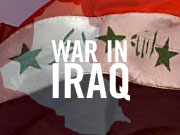Audio
Photos
More from MPR
Your Voice
| ||||||||||||||||||||||||||
Pawlenty activates operations center
March 20, 2003
 |
| Gov. Pawlenty says there are no specific threats against Minnesota, but the state needs to be prepared for that possibility. (MPR Photo/Laura McCallum) |
St. Paul, Minn. — The emergency operations center isn't exactly a hotbed of activity, at least not right now. In a large conference room in a downtown St. Paul office building, National Guard members and state officials monitor CNN and staff phones that don't ring nearly as often as they did after Sept. 11. Right after the terrorist attacks, Minnesotans had questions about gas prices and missing loved ones in New York. Now, state officials aren't sure what to expect. Gov. Pawlenty says there are no specific threats against Minnesota, but the state needs to be prepared for that possibility.
"When you have the federal government saying the onset of war is a likely trigger for acts of domestic terrorism, and get your guard up; that's what we're doing. And we want to be ready. I don't want to be sitting here two or three days from now, saying I wish we would have had the ability to have a more comprehensive and coordinated response to an incident," Pawlenty said.
Pawlenty says the emergency operations center is a place for state officials to coordinate communication, and respond to terrorist threats if necessary. Minnesotans can call the center with questions and concerns. Seven state agencies are currently staffing the center.
Minnesota's Homeland Security Director, Public Safety Commissioner Rich Stanek, says the center has been used in the past to coordinate the response to natural disasters such as floods and tornadoes. Stanek says in the event of a natural disaster, the center would be staffed by all state agencies. He says the threat of terrorism warrents a different response.
"The governor was very cautious in moving forward in terms of how we staff the emergency operations center, and rightfully so, we do not want to cause fear amongst the citizens of Minnesota, but rather just the opposite; we want them to feel assured that we're taking every step and every opportunity we can to provide for their safety, and we've done that," according to Stanek.
Gov. Pawlenty says because the center is staffed by state employees, it won't create many additional costs for the state. But he says there will be extra expenses for deploying National Guard troops around Minnesota. The governor has deployed 262 guard members to protect seven locations across the state, including the state's two nuclear power plants.
Pawlenty says the deployment costs $60,000 a day, and that amount could increase. He says he's getting requests to deploy troops to other public places. Pawlenty says he hasn't decided whether to send the Guard to other facilities, but says if he does, it will be based on certain criteria.
"They relate to the amount of damage that could be imposed by an incident or attack on one of the facilities or institutions, and they relate also to the amount of economic disruption that could occur as a result of an attack or an incident at the facilities," he said.
Pawlenty says he expects to get federal money to help with the increased costs.
In addition to the National Guard members protecting Minnesota facilities, about 800 Minnesota guard members will be deployed overseas.
Adjutant General Eugene Andreotti says the 133rd Airlift Wing is already flying missions overseas, primarily in Afghanistan and Pakistan. He says other units are preparing to head to the Middle East.
"My hats off to these young men and women, and also to their families for the job they're doing to leave all of this. One gentleman said, 'You know, I'm in the middle of my mid-semester test,' and he took off, because of the responsibilities of course, we all expect him to do that," Andreotti said.
Andreotti says another group of 28 Guard members will be deployed next week. The governor says first lady Mary Pawlenty will announce an initiative next week that would encourage Minnesotans to help the families of National Guard members who have been called up because of the war.
|
News Headlines
|
Related Subjects
|

